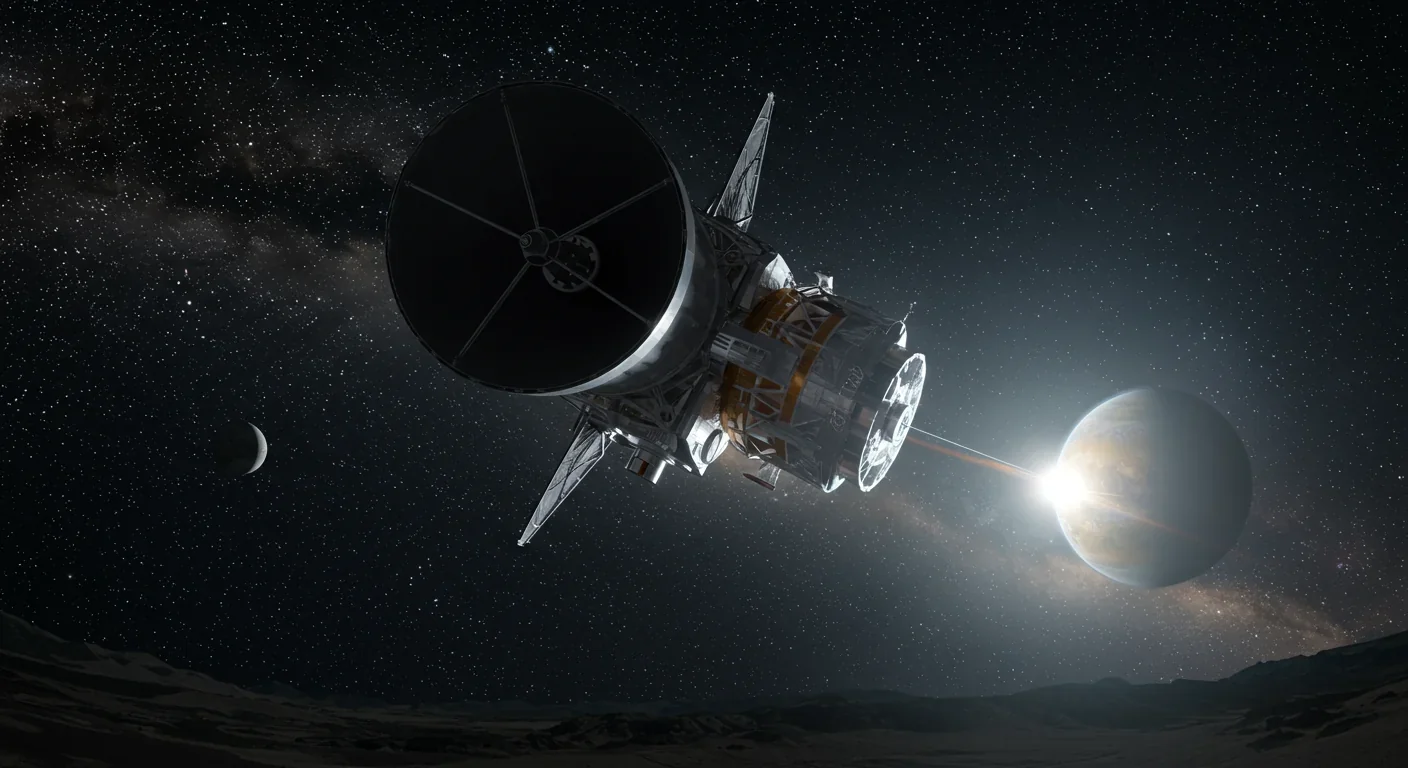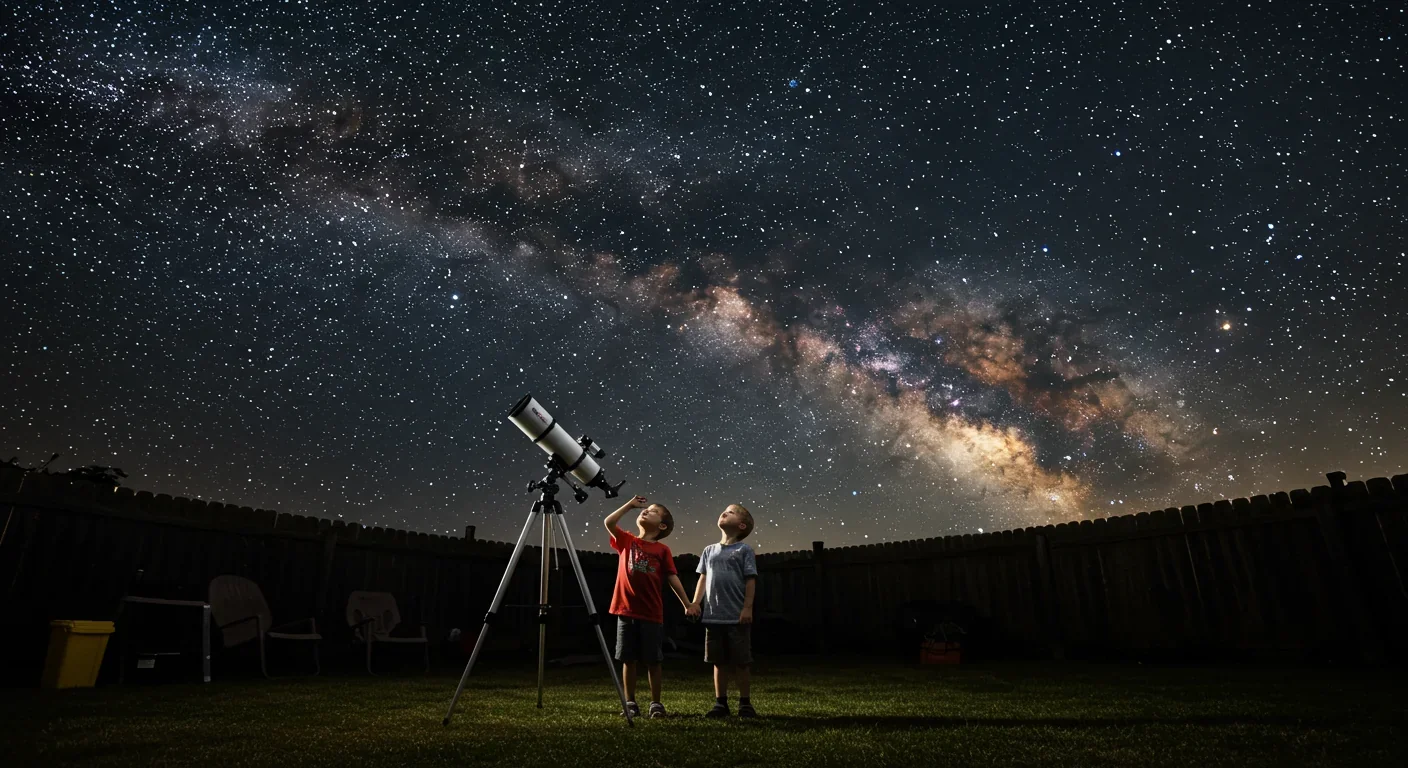Fusion Rockets Could Reach 10% Light Speed: The Breakthrough

TL;DR: Scientists use space telescopes like JWST to analyze exoplanet atmospheres for biosignatures such as oxygen and methane that could indicate alien life. While recent breakthroughs show promise, false positives and atmospheric complexity mean definitive proof may still be years away.

Imagine standing on Earth and looking up at the stars, knowing that one of those pinpricks of light harbors a planet with an atmosphere full of oxygen, methane, and water vapor. Just like ours. Now imagine you're a scientist trying to prove it from 40 light-years away. That's the audacious challenge astronomers face today as they analyze the atmospheres of distant worlds, searching for the chemical fingerprints of life. With over 6,000 confirmed exoplanets discovered and tools like the James Webb Space Telescope now operational, we're closer than ever to answering humanity's oldest question: Are we alone?
The search for life beyond Earth centers on one crucial concept: biosignatures. These are gases or chemical combinations in a planet's atmosphere that could only exist if something alive is producing them. On Earth, oxygen makes up 21% of our atmosphere, almost all of it pumped out by photosynthetic organisms over billions of years. Without life constantly replenishing it, oxygen would vanish in geological time, reacting with rocks and other chemicals. Finding oxygen, especially alongside methane and water vapor, on a distant exoplanet would be like spotting smoke from across a valley. You'd know something extraordinary was happening.
But how do you analyze air on a planet you can't even see clearly? The answer lies in light. When a planet passes in front of its star from our perspective (a transit), some starlight filters through the planet's atmosphere. Different molecules absorb specific wavelengths, leaving dark lines in the spectrum like a barcode. By studying these absorption patterns, scientists can identify what gases are present and in what quantities. It's detective work at a cosmic scale.
Biosignatures come in different flavors. Primary biosignatures include oxygen (O₂), ozone (O₃), and methane (CH₄). Secondary biosignatures might be dimethyl sulfide, phosphine, or even industrial pollutants like CFCs if an advanced civilization exists. The holy grail? Finding multiple biosignatures together, because certain combinations are nearly impossible to produce without biology. Oxygen plus methane is a perfect example. They react with each other, so finding them coexisting suggests something is constantly producing both.
For decades, scientists relied on ground-based telescopes and space observatories like Hubble to study exoplanet atmospheres. Hubble made history by detecting water vapor on several hot Jupiters, giant gas planets orbiting close to their stars. These early detections proved the technique worked, but Hubble's capabilities were limited for smaller, Earth-like planets in the habitable zone, where liquid water could exist on the surface.
Enter the James Webb Space Telescope. Launched in late 2021, JWST is a game-changer. Its massive 6.5-meter mirror and infrared instruments allow it to detect fainter signals and peer through the hazy atmospheres of distant worlds. In its first two years, JWST has already delivered stunning results, including detailed atmospheric profiles of planets in the TRAPPIST-1 system, a group of seven Earth-sized worlds orbiting a cool red dwarf star 40 light-years away.
One of JWST's most exciting contributions is studying sub-Neptunes, planets between Earth and Neptune in size. These worlds are incredibly common in our galaxy but have no equivalent in our solar system, making them mysterious. Recent research suggests many sub-Neptunes might have thick hydrogen atmospheres, cloudy conditions that complicate biosignature detection, or even lack atmospheres entirely. Understanding what's normal for these planets is crucial before we can identify what's extraordinary.
Ground-based telescopes haven't been left behind. High-resolution spectrographs on instruments like the European Southern Observatory's Very Large Telescope can detect Doppler shifts in starlight that reveal atmospheric composition. This technique complements space telescopes by observing multiple planets simultaneously, building a statistical picture of atmospheric diversity across hundreds of worlds.

The past few years have delivered both triumphs and humbling lessons. In 2024, researchers announced that K2-18 b, a sub-Neptune in the habitable zone, showed signs of dimethyl sulfide in its atmosphere. On Earth, this compound is only produced by marine phytoplankton. The finding sparked excitement, but scientists immediately cautioned that abiotic processes couldn't be ruled out. K2-18 b is likely a "Hycean world," a water-rich planet with a hydrogen atmosphere, an environment so alien to us that predicting its chemistry is challenging.
Then came the disappointments. The TRAPPIST-1 system, once considered the best candidate for finding habitable worlds, has proven more difficult than expected. JWST observations revealed that TRAPPIST-1 d likely lacks a thick atmosphere, a blow to hopes that these planets might harbor life. Similarly, planets once thought to be water worlds covered in oceans turned out to have quite different atmospheres when examined closely. What looked like water vapor signals were actually mirages, misinterpreted data that highlights how easy it is to be fooled.
These surprises underscore a critical point: exoplanet atmospheres are wildly diverse, far more so than scientists anticipated. Hot Jupiters have been found with clouds of molten rock and iron rain. Some planets have atmospheres blown away by their star's radiation. Others are shrouded in hazes that block nearly all light from penetrating. This diversity makes the search harder but also more fascinating. Every new discovery refines our understanding of what's possible.
On Mars, closer to home, NASA's Perseverance rover recently found potential biosignatures in ancient sedimentary rocks. The rock, named Cheyava Falls, contains mineral patterns that could be linked to ancient microbial life. But as with K2-18 b, researchers emphasize caution. Abiotic processes could produce similar patterns, and extraordinary claims require extraordinary evidence. The discovery illustrates how biosignature research operates: you find something intriguing, then spend years ruling out every non-biological explanation.
Here's the problem: atmospheres are messy. Gases that look like biosignatures can sometimes form through purely geological or chemical processes. Oxygen, for instance, can be produced when ultraviolet light from a star splits water molecules, releasing hydrogen into space and leaving oxygen behind. This happened on Venus billions of years ago, long before any life could have existed there. If scientists detected oxygen on a Venus-like exoplanet today, they might mistakenly interpret it as a sign of biology.
Clouds, hazes, and stellar activity add more complications. A planet shrouded in clouds might hide its true atmospheric composition, or worse, produce misleading spectral signatures that look like something they're not. Stellar flares and eruptions can pump gases into a planet's atmosphere, creating temporary chemical imbalances that mimic biological activity. Disentangling these effects requires sophisticated modeling and, ideally, observations over long time periods to see if the signals are stable.
Researchers are developing strategies to minimize false positives. One approach is looking for "disequilibrium chemistry," gas combinations that shouldn't coexist under normal physical conditions. Oxygen and methane, as mentioned, are a classic example. Another strategy involves studying the planet's broader context: its size, density, distance from its star, and the star's properties. A rocky planet in the habitable zone with oxygen is far more compelling than a gas giant too close to its star.
Still, eliminating all doubt is nearly impossible from this distance. That's why scientists talk about "confidence levels" rather than certainty. A detection with 95% confidence might sound impressive, but that still leaves a 5% chance you're wrong. When you're claiming to have found alien life, 5% isn't good enough. The threshold for truly convincing evidence will be high, requiring multiple independent observations and corroborating data from different instruments.
The search for biosignatures isn't happening in a vacuum. It's a global effort involving dozens of countries and institutions. NASA's JWST is a collaboration with the European Space Agency (ESA) and the Canadian Space Agency. ESA is also developing PLATO, a mission designed to find Earth-like planets around Sun-like stars, scheduled for launch in 2026. China has announced plans for its own space telescopes aimed at exoplanet research.
Ground-based efforts are equally international. The Extremely Large Telescope (ELT), under construction in Chile, will have a 39-meter mirror—the largest optical telescope ever built. When it comes online in the late 2020s, the ELT will be able to directly image exoplanets and study their atmospheres with unprecedented detail. Meanwhile, the Thirty Meter Telescope in Hawaii (currently delayed by local opposition) and the Giant Magellan Telescope, also in Chile, will add to this arsenal.
This international collaboration brings different perspectives and expertise. European researchers lead in developing new spectroscopic techniques, while American institutions dominate in computational modeling. Asian countries are increasingly contributing to data analysis and mission design. The hunt for life is too big and too important for any one nation or agency to monopolize.
Collaboration extends to data sharing. The NASA Exoplanet Archive is publicly accessible, allowing researchers worldwide to analyze observations and test hypotheses. Open-source software tools for atmospheric modeling are freely available. This transparency accelerates discovery and helps catch errors before false claims spread.

JWST is spectacular, but it's just the beginning. NASA is already planning its successors. The Habitable Worlds Observatory, a concept still in early design, would be optimized specifically for biosignature detection on Earth-like planets. It would use a coronagraph or starshade to block a star's glare, allowing direct imaging of planets that would otherwise be invisible in the star's brilliance. This technology would be revolutionary, enabling scientists to study dozens of potentially habitable worlds in exquisite detail.
ESA's ARIEL mission, set to launch in 2029, will survey the atmospheres of around 1,000 exoplanets, from hot Jupiters to super-Earths. ARIEL won't focus solely on biosignatures but will instead build a comprehensive atlas of atmospheric diversity, helping scientists understand the full range of planetary climates and chemistries. This statistical approach is essential because we still don't know what a "typical" exoplanet atmosphere looks like.
Closer to Earth orbit, NASA's upcoming Nancy Grace Roman Space Telescope will conduct wide-field surveys that complement JWST's targeted observations. Roman will find thousands of new exoplanets, including many in the habitable zone, giving scientists a longer target list for detailed follow-up. The combination of Roman's discovery power and JWST's analytical precision represents a one-two punch in exoplanet science.
On the ground, advances in adaptive optics are making Earth-based telescopes more powerful. Adaptive optics systems use deformable mirrors to correct for atmospheric turbulence in real-time, producing images nearly as sharp as space telescopes. This technology will make future giant telescopes like the ELT even more capable, allowing them to study fainter and more distant planets.
So when will we know if we've found life? The honest answer is, it depends. If a nearby planet shows clear, unambiguous biosignatures—oxygen, methane, water vapor, and maybe even industrial gases—we could have strong evidence within the next decade. But "strong evidence" doesn't mean certainty. It means a compelling case that would shift the scientific consensus toward "probably biological" while leaving room for alternative explanations.
If the signals are more subtle or ambiguous, confirmation could take decades. Imagine detecting dimethyl sulfide on a Hycean world but needing 20 years of observations to rule out all abiotic sources. Or finding oxygen on a planet whose star's activity makes interpretation difficult, requiring new theoretical models and multiple independent observations. Patience will be as important as technology.
There's also the possibility that life is common but hard to detect. Microbial life on early Earth didn't produce oxygen for billions of years. If most inhabited planets are in a similar pre-oxygen stage, their biosignatures might be faint or non-existent from our perspective. We might be surrounded by alien microbes but lack the tools to see them yet.
Public expectations matter too. When headlines scream about "potential biosignatures," many people assume we've found aliens. Scientists then face the awkward task of tempering that enthusiasm, explaining that "potential" means "maybe" and "needs further study." Managing these expectations is crucial for maintaining public support for missions that cost billions and take decades to bear fruit.
Why pour so many resources into this search? Because answering whether life exists elsewhere would fundamentally reshape humanity's understanding of itself and the universe. If we find life, even microbial life, it suggests life is abundant. That the universe teems with biology, perhaps even intelligence. The Fermi Paradox—why haven't we heard from anyone?—becomes even more urgent.
If we don't find life after exhaustively searching hundreds of potentially habitable worlds, that's equally profound. It would suggest life is rare, perhaps vanishingly rare. Earth might be an extraordinary fluke, a cosmic accident that hasn't been repeated elsewhere. That possibility should make us treasure our planet even more, knowing how unique and fragile it might be.
The search also drives technological innovation. The techniques developed for analyzing exoplanet atmospheres have applications in climate science, materials engineering, and medical imaging. Simulations of planet formation help us understand how Earth came to be and whether our solar system's architecture is typical or unusual. The knowledge gained ripples outward, benefiting fields far beyond astronomy.
And there's something deeply human about looking up and wondering. Our ancestors did it around campfires. Renaissance astronomers did it with telescopes. Today, we do it with space observatories and supercomputers. The tools change, but the fundamental question remains the same: What's out there? That question, more than any other, captures what it means to be human—curious, ambitious, and unwilling to accept that we're alone in the vastness of space.

Recent breakthroughs in fusion technology—including 351,000-gauss magnetic fields, AI-driven plasma diagnostics, and net energy gain at the National Ignition Facility—are transforming fusion propulsion from science fiction to engineering frontier. Scientists now have a realistic pathway to accelerate spacecraft to 10% of light speed, enabling a 43-year journey to Alpha Centauri. While challenges remain in miniaturization, neutron management, and sustained operation, the physics barriers have ...

Epigenetic clocks measure DNA methylation patterns to calculate biological age, which predicts disease risk up to 30 years before symptoms appear. Landmark studies show that accelerated epigenetic aging forecasts cardiovascular disease, diabetes, and neurodegeneration with remarkable accuracy. Lifestyle interventions—Mediterranean diet, structured exercise, quality sleep, stress management—can measurably reverse biological aging, reducing epigenetic age by 1-2 years within months. Commercial ...

Data centers consumed 415 terawatt-hours of electricity in 2024 and will nearly double that by 2030, driven by AI's insatiable energy appetite. Despite tech giants' renewable pledges, actual emissions are up to 662% higher than reported due to accounting loopholes. A digital pollution tax—similar to Europe's carbon border tariff—could finally force the industry to invest in efficiency technologies like liquid cooling, waste heat recovery, and time-matched renewable power, transforming volunta...

Humans are hardwired to see invisible agents—gods, ghosts, conspiracies—thanks to the Hyperactive Agency Detection Device (HADD), an evolutionary survival mechanism that favored false alarms over fatal misses. This cognitive bias, rooted in brain regions like the temporoparietal junction and medial prefrontal cortex, generates religious beliefs, animistic worldviews, and conspiracy theories across all cultures. Understanding HADD doesn't eliminate belief, but it helps us recognize when our pa...

The bombardier beetle has perfected a chemical defense system that human engineers are still trying to replicate: a two-chamber micro-combustion engine that mixes hydroquinone and hydrogen peroxide to create explosive 100°C sprays at up to 500 pulses per second, aimed with 270-degree precision. This tiny insect's biochemical marvel is inspiring revolutionary technologies in aerospace propulsion, pharmaceutical delivery, and fire suppression. By 2030, beetle-inspired systems could position sat...

The U.S. faces a catastrophic care worker shortage driven by poverty-level wages, overwhelming burnout, and systemic undervaluation. With 99% of nursing homes hiring and 9.7 million openings projected by 2034, the crisis threatens patient safety, family stability, and economic productivity. Evidence-based solutions—wage reforms, streamlined training, technology integration, and policy enforcement—exist and work, but require sustained political will and cultural recognition that caregiving is ...

Every major AI model was trained on copyrighted text scraped without permission, triggering billion-dollar lawsuits and forcing a reckoning between innovation and creator rights. The future depends on finding balance between transformative AI development and fair compensation for the people whose work fuels it.